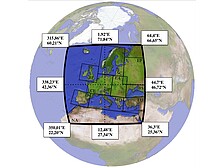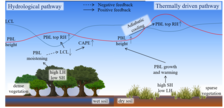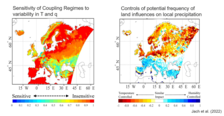An assessment of land-atmosphere coupling strength due to land use change in the past and under two future climate scenarios in Europe
Lisa Lea Jach
Lisa was defending her PhD thesis in Frebuary 2023.
University of Hohenheim, Stuttgart
Institute for Physics and Meteorology (120)
Challenges
Climate projections are a major tool i.a. for estimating increasing human health risks due to floods, droughts or extreme temperatures in the future. But, especially precipitation projections are subject to huge uncertainties, because the formation of precipitation is a complex process including local and non-local contributions and exchange fluxes. Disentangling local and non-local signals and therefore the accurate assessment of land surface contribution to changing climate is difficult.
Nevertheless, land use changes are expected to regionally have a significant impact on the climate, and they are usually not implemented in regional climate models, yet. Also, biogeophysical impacts are barely understood and respected in impact analysis of land use changes. Up to now, several coupling metrics have been developed which target the investigation of single up to several steps in the local coupling process chain, which is a simplification for the complexities of the triggering of precipitation. The land surface state is usually represented by available soil moisture. However, land use changes also alternate transpiration rates and available energy for flux partitioning. Therefore, they also need to be considered when analyzing the impacts of land use changes on the climate system.
Objectives
- Set up past (1986-2005) and future (2006-2100) land use change experiments and assess the contribution of the land surface to changes in temperature and precipitation patterns
- Analyze the outcome regarding differences in the land atmosphere coupling strength and target the understanding of biogeophysical feedbacks leading to differences in the coupling strength
- Identify regions of strong/weak coupling between land surface and atmosphere under changing climatic conditions
Expected results
More robust identification of the location and nature of strong feedbacks in Europe. An analysis of the trend in coupling strength in dependence of land use and climate forcing. Increased understanding of precipitation patterns in Europe.
Aims
The aim of this study is to assess the impact of realistic land use changes on the past and future climate. Focus will be put on investigating regional differences in land-atmosphere coupling strength and mechanisms at the land surface that control these differences. All analysis function as a basis for an assessment of the potential land surface impact on convection triggering and the land use change potential for mitigating climate change.
Methods
The atmosphere model WRF coupled to the land surface model NOAH-MP will be used to set up three sets of climate simulations for Europe each containing one run with currently prevailing land use (noLUC) and one with land use changes (LUC):
- One evaluation set forced with reanalysis data for the period 1986-2015,
- one historical set which is driven by a general climate model for the period 1986-2005 and
- two sets of future runs for the period 2006-2100 also driven by a general climate model, one based in the RCP2.6 forcing scenario and one on the RCP8.5 forcing scenario.
The results will be evaluated compared in long-term means and as time series with regard to regional land use change contribution to land-atmosphere coupling strength applying statistical and process-based coupling metrics.
These simulations are a contribution to the Flagship Pilot Study – Land Use and Climate Across Scales (LUCAS), which was launched in 2017 by the European branch of the CORDEX as well as the LUCID communities.
Peer reviewed publications:
1. Davin,E.L., Rechid, D., Breil, M., Cardoso, R.M., Coppola, E., Hoffmann, P., Jach, L.L., Katragkou, E., de Noblet-Decoudré, N., Radtke, K., Raffa, M., Soares, P.M.M., Sofiadis, G., Strada, S., Strandberg, G., Tölle, M.H., Warrach-Sagi, K., Wulfmeyer, V., 2020. Biogeophysical impacts of forestation in Europe: First results from the LUCAS (Land Use and Climate Across Scales) regional climate model intercomparison. Earth System Dynamics, 11, 183-200.
2. Jach,L., Warrach‐Sagi,K., Ingwersen,J., Kaas,E., Wulfmeyer,V, 2020. Land Cover Impacts on Land‐Atmosphere Coupling Strength in Climate Simulations With WRF Over Europe. Journal of Geophysical Research: Atmosphere, 125
3. Breil,M., Rechid,D., Davin,E.L., De Noblet-Ducourdré,N., Katragkou,E., Cardoso,R.M., Hoffmann,P., Jach,L.L., Soares,P.M.M., Sofiadis,G., Strada,S., Strandberg,G., Tölle,M.H., Warrach-Sagi,K., 2020. The opposing effects of re/af-forestation on the diurnal temperature cycle at the surface and in the lowest atmospheric model level in the European summer. Journal of Climate, 33: 9159-9179




